
Utrecht is the fourth-largest city of the Netherlands, as well as the capital and the most populous city of the province of Utrecht. The municipality of Utrecht is located in the eastern part of the Randstad conurbation, in the very centre of mainland Netherlands, and includes Haarzuilens, Vleuten and De Meern. It has a population of 361,699 as of December 2021.
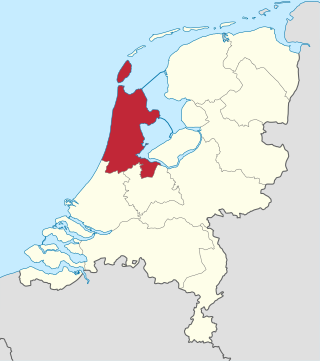
North Holland is a province of the Netherlands in the northwestern part of the country. It is located on the North Sea, north of South Holland and Utrecht, and west of Friesland and Flevoland. As of January 2023, it had a population of about 2,952,000 and a total area of 4,092 km2 (1,580 sq mi), of which 1,429 km2 (552 sq mi) is water.

There are twelve provinces of the Netherlands representing the administrative layer between the national government and the local governments, with responsibility for matters of subnational or regional importance.

The national flag of the Netherlands is a horizontal tricolour of red, white, and blue. The current design originates as a variant of the late 16th century orange-white-blue Prinsenvlag, evolving in the early 17th century as the red-white-blue Statenvlag, the naval flag of the States-General of the Dutch Republic, making the Dutch flag the oldest tricolour flag in continuous use. As a flag that symbolises the transformation from monarchy to republic, it has inspired both the derivative Russian flag, and after the French Revolution in 1789, the vertically striped French tricolour; both flags in turn influenced many other tricolours. During the economic crisis of the 1930s, the old Prince's Flag with the colour orange gained some popularity among some people. To end the confusion, the colours red, white and blue and its official status as the national flag of the Kingdom of the Netherlands were reaffirmed by royal decree on 19 February 1937.
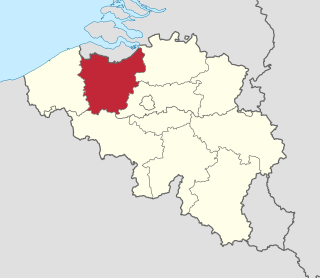
East Flanders is a province of Belgium. It borders the Dutch province of Zeeland and the Flemish province of Antwerp, Flemish Brabant, Hainaut and West Flanders. It has an area of 3,007 km2 (1,161 sq mi), divided into six administrative districts containing 60 municipalities, and a population of over 1.57 million as of January 2024. The capital is Ghent, home to the Ghent University and the Port of Ghent.

The flag of North Brabant consists of a chequy pattern with 24 distinct fields in the colours red and white or gules and argent. The flag has been used since the Middle Ages, but fell into disuse in the 18th century. The flag is now back in use, and has been the official flag of North Brabant since 1959.
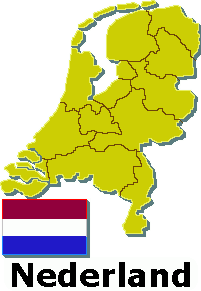
This list contains all twelve official flags of the provinces of the Netherlands, including the pennons.

The flag of Drenthe is the official flag of the Dutch province of Drenthe and was adopted on 19 February 1947. This flag was designed by Gerlof Auke Bontekoe. The traditional Saxon colours of red and white form the basis of the design. They also link it to the Archdiocese of Utrecht, which administered Drenthe when the area was still part of the Oversticht. Between the white base colour and the two red bands are six red stars and a black tower. The stars represent the districts Zuidenveld, Oostenmoer, Noordenveld, Rolde, Beilen and Diever. The tower is a historical reference to Coevorden Castle. From this castle, the viscounts of Coevorden maintained the law in the name of the bishop of Utrecht for a long time.
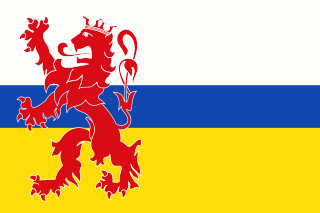
The flag of Limburg is a flag with the ratio of approximately 1:2. It consists of 3 rows of colors in a size ratio of 2:1:2. The colors used are white, blue and gold (yellow). The flag was adopted by decree of the provincial executive of Limburg on 28 July 1953.

The flag of South Holland was adopted on 24 October 1985, replacing the flag used since 22 June 1948. The flag shows a red lion standing out prominently against an even yellow background. The flag of the most populous province is a banner of arms of the South Holland coat of arms. This shield is in turn grafted onto the coat of arms of Holland. The colour choice is also obvious; after all, yellow and red have traditionally been the colours of the province of Holland. Remarkably, the aspect ratio of the South Holland flag is 2:3, the same dimensions that also apply to the national tricolour. The left-facing lion, standing on its hind legs, occupies three-quarters of the flag's height and is equally distant from the top and bottom. The colours red and yellow are Holland's traditional colours and are also found of the flag of North Holland.

The Frisian flag is the official flag of the Dutch province of Friesland. The flag was officially adopted by the provincial executive of Friesland on 9 July 1957.
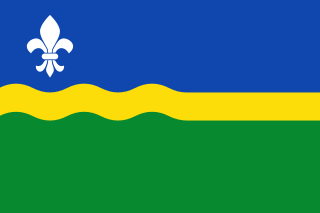
The flag of Flevoland was hoisted for the first time on 9 January 1986, and it was formally defined as the provincial flag on 15 February 1989.

The flag of the Caribbean Netherlands island of Sint Eustatius (Statia) consists of a blue field, red fimbriations, and in the center, a white diamond with a silhouette of the island. The flag was designed by Zuwena Suares and adopted on 29 July 2004 to be put into use on 16 November of that year. Since 2010, it has been the official flag of the special municipality of Sint Eustatius.
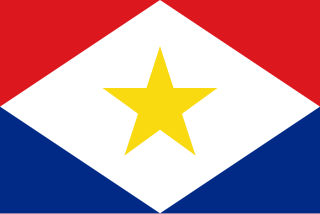
The flag of Saba was adopted on 6 December 1985. 130 different designs were presented to the commission. The chosen flag was designed by an 18-year-old Saban named Edmond Daniel Johnson.

The flag of North Holland is the official flag of North Holland. The flag consists of three horizontal bands executed in the colours yellow, red and blue. The colours are taken from the coat of arms of North Holland. This in turn is a combination of the old coats of arms of North Holland and West Friesland. Yellow and red belong to Holland, while blue is part of the West Frisian identity. The current design was adopted by the Provincial Council on 22 October 1958 as the official tricolour of North Holland. The colour sequence of the North Holland flag was also determined this way in the current design because otherwise the flag would look too much like the red-white-blue striping pattern of the Dutch flag.
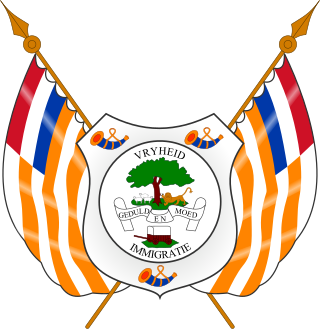
The coat of arms of the Orange Free State was the official heraldic symbol of the Orange Free State as a republic from 1857 to 1902, and later, from 1937 to 1994, as a province of South Africa. It is now obsolete.

The Statenvlag is the name of the flag of the States-General of the Dutch Republic, the red-white-blue tricolour flag replacing the older orange-white-blue Prince's Flag in the mid 17th century. The modern national flag of the Netherlands, the exact colours of which were confirmed in 1937, is based on this historical flag. It also resembles the modern Flag of Luxembourg.

The Flags of the United States of Indonesia refers to the state flags that were used as the official state symbols of the United States of Indonesia, the predecessor state of the Republic of Indonesia. The flag that were hoisted during the proclamation of independence on 17 August 1945 remained as the official flag of the United States of Indonesia after its transfer of sovereignty on December 27, 1949, and it was written on the Federal Constitution of 1949.


















